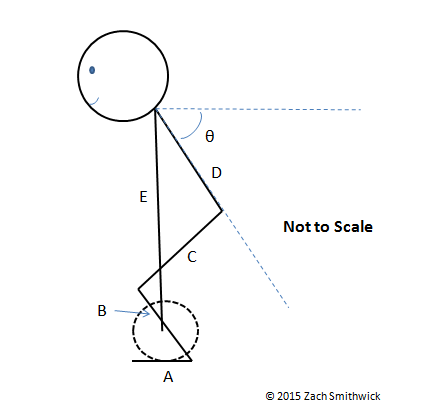I started deadlifting a few months ago, and it has proven to be an excellent exercise for total body strength. As a novice deadlifter, I was (and still am) constantly worried about injuring my back, as deadlifts are often given this nasty reputation (and also the most common excuse people give for not doing them).
I've watched more deadlift tutorials on youtube than I can count, but I was always lost when it came to the question "how much should my knees be bent / how high should my hips be when deadlifting?" In all the videos I watched, people's deadlifts seem to look different. Some people bent their knees almost like a squat, others barely bent them at all.
I finally realized that this wasn't an issue of form, it was an issue of body proportions. All the elite powerlifters I was watching were utilizing good form, but they all looked different because their bodies were put together differently. Being the mathematical type that I am, I wanted to know what back angle I should have when I deadlift, so I decided to figure it out.
Some Important Caveats
This is by no means an official calculator that you should treat as gospel. It makes a few simplifications to make the math easier, which will affect the accuracy of the end result.
Assumptions made:
1) In keeping with the proper deadlift form that I have learned from multiple sources, this calculator assumes that the bar is placed over the mid-foot, the shins touch the bar, and the shoulder blades are directly over the bar.
2) The bar is elevated off the ground due to a 45 lb plate being loaded onto each side (or a plate of equivalent diameter). The assumed diameter is 18 inches, which makes the bar 9 inches off the ground.
3) The person is a stick figure, and therefore the foot has no height, the shin has no width, etc. This is of course an inaccuracy induced to make the math easier.
4) The arms are perpendicular to the ground. Now, I realize that if the shoulder blades are directly over the bar then the arms will make a slight angle with the ground, so this is another inaccuracy that I tolerated in order to make the math easier. If there is enough interest then maybe one day I'll re-do the calculations for greater accuracy.
5) Stance width is negligible. This, I feel, is a fairly decent approximation. Since the deadlift stance width (for conventional) is relatively narrow compared to the length of most people's legs, the resulting "effective leg length" is pretty close to the actual leg length. The effective leg length is the root-square-difference of the actual leg length and half the stance width, which boils down to a fairly trivial difference.
Consult the picture below for a clarification on the lengths you will need to measure for yourself:
A: Foot length: pretty self explanatory
B: Shin length (more than the shin, but that's what I call it). For this, I measured from the bottom of my foot to right in the middle of my knee, and that seemed to give the best result.
C: Thigh length (or whatever this is called, anatomy is clearly not my thing): I measured from the middle of my knee to my hip bone, and that seemed to work okay.
D: Torso length: This one is tricky. In actuality, it should be the length from the hip joint to the shoulder blade, but I seemed to get the most accurate measurements when I did it from my hip to my shoulder point (it was also easier to do alone).
E: Arm Length: I did it from my shoulder point to my big knuckle, and that seemed to work. It isn't the length to your fingertips, because you aren't holding the bar with your fingertips!
The angle  represents the back angle with respect to the horizon. If the angle is negative, it means that your hips will be higher than your head. As far as I know, this is not impossible, and would arise if you have long legs and short arms.
represents the back angle with respect to the horizon. If the angle is negative, it means that your hips will be higher than your head. As far as I know, this is not impossible, and would arise if you have long legs and short arms.
[CP_CALCULATED_FIELDS id="6"]
As far as accuracy goes, my result gave me about 5 degrees below the horizon. Judging by a picture of my form, I would say the real angle is probably more like 10-15 degrees, but the moral of the story (for me) is that my hips will be relatively high since I have longer legs and not longer arms.
Like I said, this has some inaccuracies, but the goal isn't for you to go to the gym with a sextant and get your exact angle, it is to give you a good idea for what your back angle will be due to your proportions. That way, if a bro in the gym comes up to you and goes "hey man, your hips are too high/low" you can look at him and confidently say "no they aren't, that's just how I'm built," and proceed to rock his world with some math.
Speaking of math, if you were wondering what the actual equation is for the back angle, here ya go:
 degrees
degrees
And you thought you wouldn't have to do math to be a weightlifter...
Let me know if you have any questions or concerns, and be sure to deadlift safely!



